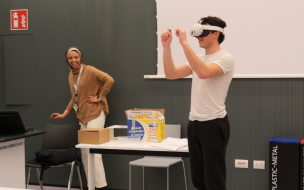It was spiffing news. Kevin, an educator at one of America’s most prestige universities, was pioneering a new learning revolution, designed to buttress the business school.
His massive online course, set to teach the world gamification techniques, would bring a new teaching style to the forefront of management education. For a mere $49 registration fee to use Coursera, an online platform, anyone could hoard his free knowledge.
More importantly, the offering would create a pumped-up spread of business programs, which could funnel talent into the expensive post-graduate programs being run at Wharton.
The business school community, slow to adapt to a technological upheaval, had long suspected that changing times were coming.
Kevin’s Mooc, a term that would grow fast and fester within the world’s MBA providers, was part of a wider shake-up that was seen for some as an answer to declining enrolment.
Schools’ full-time MBA programs were flagging. The boom experienced in the aftermath of the financial crisis, when sluggish economies sent executives to MBA programs in their droves, was threating to bust.
Startlingly low and flat applicant figures in the years since 2009 have got some schools worried. Moocs are only part of the puzzle.
The traditional MBA market faces woes in the form of resurgent recoveries, part-time and online programs, specialist learning programs and professional qualifications, and Europe’s increasingly revered one-year MBA model. Pre-experience programs continue to poke a hole in business models, too.
The problems have rolled in thick and fast. The statistics paint a gloomy picture. GMAC, administrators of the GMAT entrance exam, have not eased tension. Their yearly applicant survey revealed some dark truths.
For every year since 2009, two-year MBA programs, America’s not-so-secret weapon, have flopped. By 2011, 67% of all such MBA programs surveyed by GMAC reported drops in applications. Between 5% and 10% of programs say applications are flat. Figures got better last year, when 46% of programs reported a drop – but that is scant consolation.
The release of application figures for 2014, revealed later this year, will be eagerly anticipated, particularly in the US.
We reported earlier this year that elite American schools revealed surprisingly high intakes for the class of 2016. At UNC's Kenan-Flagler Business School, full-time MBA applications surged 28%, and at Georgetown’s McDonough School of Business applications similarly topped 20%.
But these figures are deceptive. GMAC data show that about half of school’s world-wide on one and two-year MBA courses report decreases. About 4% remained flat. If there is a boom, it is only felt at a handful of business schools.
Privately, admissions officers complain at the lack of suitable candidates for their MBA programs. While total applications have risen at some of these elite schools, they are not accepting higher numbers of candidates. It all looks good on paper.
Instead, they are cherry-picking candidates whom they see as ideal. For US schools, this will be more international candidates. America has long languished behind Europe in that respect.
The figures back-up this story. Application rises were lower among international candidates – 7% lower at McDonough, for example. At other schools international applications remained flat.
Paul J. Binder, associate director of graduate career services at the Kelly School of Business, says: “It’s an expensive proposition to go for a two-year MBA at a credible school, so people think about it because if they have to take loans out [then] they’re really in the hole when they graduate.”
Figures for the GMAT, part of most schools' admissions requirements, tell the same tale. Over the past six years the number of test-takers has remained flat at about 240,000.
However, the numbers taking the GMAT in the US have fallen steadily over the past four years. The overall figure is propped up by increased interest in Asia.
Europe’s model of shorter, more intense MBA programs is winning trade. In response, Americans are now warming to the idea of one-year programs.
More than half of full-time one-year MBA programs in the United States reported increased application volumes for the 2013–2014 application cycle, according to GMAC’s survey, on the back of 54% reporting increases a year earlier.
Some US schools now want to adopt the European model. Northwestern University’s Kellogg School of Management plans to increase the number of one-year MBA participants. Cornell’s Johnson School recently launched a one-year MBA program for candidates with technical backgrounds.
The Fuqua School of Business and Michigan Ross now have mid-length programs lasting 16 months.
Andrei Stephens, an American who studied at the UK’s Saïd Business School, says: “I saw the one-year international business school model as more attractive… I wasn't trying to get a job at a big investment bank or [a] consultancy, so the two-year summer internship model wasn’t appropriate to my goals.”
Part-time and online MBA interest has also increased, while specialized master degrees and professional qualifications have gained ground at the expense of the full-time MBA.
The CFA has been billed as the new MBA degree for those seeking finance careers. The number of professionals who have the CFA qualification has more than doubled in ten years to about 109,000.
Lancaster University Management School recently launched a specialist master program aimed at preparing students for CFA Level I.
Steve Young, professor of accounting at Lancaster, says: “Given the increasing importance and popularity of the CFA qualification, we considered it appropriate to offer our students a significant amount of dedicated training delivered by professional CFA tutors.”
There have been suggestions that pre-experience programs may pose a threat to the MBA program, most of which require several years’ work experience.
Many of these non-experience programs specialize in a particular function or industry, and candidates are typically in their early 20s. It is thought that they are unlikely to want to begin an MBA in later life.
Others, however, are unconvinced by their appeal. “The ‘fresher’s MBA’ – the trouble they are causing for UK admissions. There are a few UK institutions that offer an MBA without work experience; do they have the ethos of an MBA or [are they] jumping on a gravy train?” said one business school professor, who did not want to be named.
There is further uncertainty for business schools. Applicants are now applying to several different MBA programs.
A recent survey by Stacy Blackman Consulting found that more than 25% of applicants plan to apply to five schools this year, an increase on 2013.
But technology remains the biggest threat to the MBA market. Two years after pressing ahead with their first Mooc, Wharton issued a damning assessment of its potential impact last week.
A school report, Will Video Kill the Classroom Star?, estimates that business schools pay professors about $200,000 per year, and says that it costs $1,475 to provide a student a course via a tenured or tenure-track MBA professor.
Yet the report argues that it costs just $11.20 to teach a student a Mooc course – the total development of a program totalling about $70,000. The professors say that using a course administrator instead of a tenure-track faculty member could save schools a further 40% in finances.
Mooc technology – chunked asynchronous video content created by an expert – has the potential to “destroy full-time MBA programs as we know them today”. The report adds: “We believe the technology is likely to be irresistible and adopted in the long run.”
RECAPTHA :
3a
c6
5e
7b








